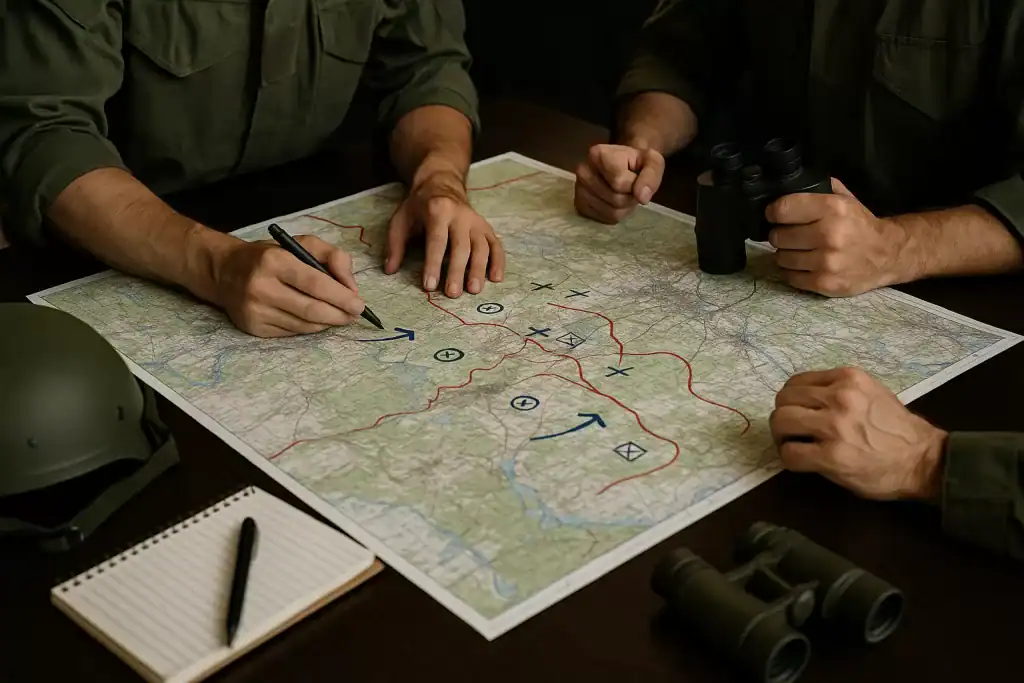By Justin Shaffer | Growth Navigator Solutions

In the military, we trained for moments of uncertainty. The pressure was real. The risks were high. And no one—especially the leader—had all the answers.
We couldn’t afford groupthink. The cost of silence or false agreement was too high. So we built in systems to challenge assumptions, raise concerns, and test ideas. That discipline saved lives.
In business, the stakes are different—but the danger is the same. Groupthink quietly erodes innovation, clouds decision-making, and creates a culture where no one says what they really think. And just like in combat, by the time you realize it’s happening, it’s often too late.
What Does Groupthink in Business Look Like?
Groupthink doesn’t announce itself. It doesn’t show up in the KPIs or write itself into the meeting agenda. It starts subtly:
- Fewer questions being asked
- New ideas that die before they’re explored
- Decisions made in hallway conversations instead of in the open
- Conflict that gets avoided, rather than resolved
It’s not disagreement that kills businesses—it’s the lack of it.
Jim Collins documented this in Good to Great, where he highlighted companies that were once industry giants—Circuit City, Fannie Mae, Gillette, and Pitney Bowes—that later declined or disappeared. These weren’t companies lacking talent or resources. What faded over time was courage. Bold leadership gave way to comfort. Strategic thinking was replaced by group alignment. Challenge disappeared.
What followed?
- Innovation slowed
- Accountability faded
- Leaders managed process instead of casting vision
- Everyone was busy, but no one was building
And most critically, leadership shifted from inspiring people to simply managing them.
That’s the real risk. Because when leaders stop inspiring and only manage systems, the business plateaus—or worse, declines. Progress stalls. Culture weakens. People stop believing the mission matters.
How the Military Builds in Challenge
One thing the military gets right is that it institutionalizes challenge. Every unit has an intelligence section—S2—whose job is to think like the adversary and push against assumptions. Their purpose isn’t to be agreeable. It’s to make the plan stronger by asking the hard questions no one else is thinking about.
This isn’t accidental. It’s built into how we operate because we’ve learned the cost of groupthink the hard way.
That same intentionality is needed in business. Especially in small and mid-sized companies where the margin for error is tighter and relationships often blur the lines between harmony and honesty.
Productive Debate vs. Toxic Conflict
What Healthy Debate Sounds Like in High-Trust Teams
Let’s be clear: this isn’t about encouraging arguments or setting leaders against each other. Productive debate is not the same as toxic conflict.
Toxic conflict is personal, emotional, and unproductive. It’s driven by ego or fear. It’s what happens when leaders aren’t aligned on values or goals.
Productive debate, on the other hand, is built on trust. It’s the willingness to challenge an idea without questioning the person. It’s knowing you can disagree in the meeting and still have each other’s back outside of it.
But that kind of culture doesn’t happen on its own. It takes intentional leadership and daily reinforcement. And that’s where many leadership teams fall short—they assume harmony is health.
It’s not.
And healthy debate can’t just go one direction.
Leadership teams should absolutely challenge the CEO, the Visionary, or the owner—but that can’t be the only direction of feedback. Leaders must also build teams that are willing to be challenged in return. That means creating a space where every person at the table is expected to bring ideas, push back, and sharpen one another.
As the leader, your job isn’t to suppress debate. It’s to create it, participate in it, and respond with clarity. Ask hard questions. Push your team’s thinking. Let them do the same to you. That’s what 360-degree debate looks like. And when the decision is made, everyone moves forward with alignment and confidence.
Building This in My Work With Clients
How I Guide Leadership Teams Through Debate and Alignment
I see this firsthand with my clients. When we first start working together, most leadership teams either avoid conflict altogether or let it spill out in unproductive ways. My job isn’t just to help them communicate better. It’s to help them build the right kind of conflict into their decision-making process.
At every offsite session, we revisit the long-term vision—the 7- to 10-year goal—and check progress against the milestones they’ve committed to. Before we shift tactics or change direction, we pause and ask: “Does this still take us where we said we want to go?”
That question forces clarity. And it creates space for people to challenge decisions without challenging authority.
As their guide, I dig in to ensure there’s both weigh-in and buy-in. We don’t just ask if everyone agrees. We ask if everyone feels heard. We test the logic behind the decisions and give space for the disagreement before the plan is finalized.
At some point in every session, we also shift our focus to team health. Even when the debate is healthy and productive, it can still create tension. And if that tension isn’t addressed, it starts to degrade trust and collaboration over time.
That’s why I always carve out time to reinforce the bigger truth: everyone at the table is there for a reason. They’re capable. They’re trusted. They’re up to the challenge—even when they see things differently. Disagreement doesn’t mean dysfunction. It means we’re thinking.
The best teams leave aligned, even if they disagreed along the way. Not because we smoothed over the tension, but because we worked through it together.
The Culture You Build Is the One You Reinforce
Daily Leadership Habits That Shape Culture
This doesn’t happen at one retreat or over a single strategy day. It’s built in every conversation. It’s reinforced by the way leaders listen, the space they make for honest discussion, and the courage they show in admitting when they don’t have all the answers.
Your culture either encourages challenge or protects comfort. It cannot do both.
If your team can’t challenge you, they can’t help you grow.
So ask yourself: What are you doing this quarter to break the cycle of groupthink?

